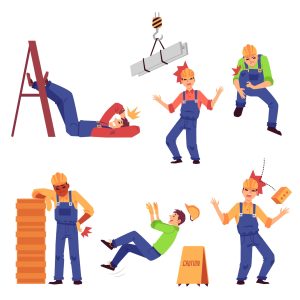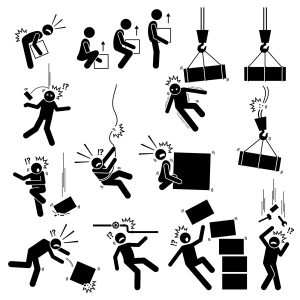The construction industry is perhaps one of the most dangerous to work in. As such, construction workers face many potential risks on a daily basis. In this guide, we look at some of the most common injuries for construction workers and when they could lead to an accident at work claim.
As you continue, you’ll read about some common construction accidents such as falls from height and manual handling injuries. You’ll also learn the criteria that need to be met before a personal injury claim can be made and how compensation is calculated under two heads of claim.
Additionally, we explain the time limits that apply to construction accident claims and the types of evidence that can improve your chances of being compensated.
Finally, we set out how you might benefit from the support of a No Win No Fee solicitor from our panel if your claim is valid.

To help you check whether you might have a valid claim, we provide a no-obligation initial consultation. Therefore, for free advice about your claim, you can:
- Phone 020 8050 2736.
- Use our live chat service.
- Start your claim online.
For more on construction site accident claims, please read on and feel free to call our team if you have any questions.
Browse Our Guide
- Falls From Height
- Defective Machinery Accidents
- Manual Handling Injuries
- When Are You Able To Claim For Common Injuries For Construction Workers?
- How Much Compensation Could You Receive From Construction Industry Accidents?
- Is There A Time Limit To Making A Construction Accident Claim?
- Why Is Evidence Crucial When Claiming For Common Injuries To Construction Workers?
- Why Use No Win No Fee Solicitors To Help You Claim Compensation?
- Learn More About Claiming For Common Injuries To Construction Workers
You might be able to claim for some common injuries in construction if it can be proven that your injuries were sustained because a party such as your employer breached their duty of care towards your well-being and this led to an accident in which you were injured. Proving such a breach is a vital part of the claims process and something we’ll review in more detail shortly.
Certain types of accidents that take place in the workplace need to be reported to the Health and Safety Executive (the HSE), Britain’s workplace health and safety regulator, under the Reporting of Injuries, Diseases and Dangerous Occurrences Regulations 2013 RIDDOR. The HSE publish accident-at-work statistics from the reporting under RIDDOR along with figures provided by the Labour Force Survey LFS. In the sections below, we will look at some of these statistics.
We’ll review how a fall from height, manual handling injuries and defective machinery construction accidents could all allow you to claim construction accident compensation.
Falls From Height
According to RIDDOR reporting, on average, over 2020/21-2022/23, the most common non-fatal injuries in construction were caused by slips, trips and falls on the same level, 26%, followed by falls from height at 20%, then manual handling accidents at 17%. On average over 2018/19-2022/23, the most common fatal construction accident was falls from height at 51%.
Injuries that could be caused to construction workers due to falls from height could include:
- Serious back injuries
- Spinal cord injuries
- Head and brain injuries
- Traumatic brain injuries
- Multiple fractures.
- Serious life-changing injuries.
Unfortunately, some falls from height can also result in fatal injuries in construction.
Accident at work claims may be possible following a fall from a height if the incident and your injuries were caused by negligence.
For example, if you fell from a tall ladder because your employer failed to check it for defects regularly or you fell from a roof because your employer failed to provide a safety harness, then you could be eligible to claim for the injuries sustained.
Defective Machinery Accidents
According to the reporting under RIDDOR, on average, over 2018/19-2022/23, 12% of fatal injuries were suffered because machinery or other items in the workplace collapsed or overturned. The Provision and Use of Work Equipment Regulations 1998 requires people and companies who own, operate or have control over work equipment to ensure they are safe for use.
A defective piece of machinery could put you at risk of being injured on a construction site. This type of accident could result in:
- Amputation of arms, hands or fingers.
- Broken bones.
- Crush injuries
If those responsible for the work equipment, such as your employer, fail to ensure the equipment is safe for its intended use, maintained in a safe condition and inspected and fails to ensure that those using the equipment are fully trained could be liable should an accident occur in which workers suffer injuries.
In such cases, you might have the grounds to begin a personal injury claim for any suffering you’ve endured.
Manual Handling Injuries
Manual handling injuries on construction sites could be claimed for if your employer fails to follow the Manual Handling Operations Regulations 1992 and you are injured as a result.
According to statistics published by the HSE from the LFS, 1.8 million workers had work-related ill health (new or long-standing) in 2022/23, of which 27% suffered musculoskeletal disorders. 17% (RIDDOR) of non-fatal injuries on construction sites are caused by lifting and carrying on average between 2020/21 – 2022/23.
The following injuries could result from manual handling accidents on a construction site:
- Back and spinal injuries.
- Shoulder and arm injuries.
- Sprains and strains.
You could be entitled to make a manual handling injury claim if your suffering was caused because health and safety regulations were not followed. For example, if your employer failed to provide manual handling training, did not risk assess hazardous lifting or did not provide the necessary equipment needed to complete heavy lifting tasks.
What Are Other Common Accidents For Construction Workers?
- Slips, trips and falls – leading to broken bones, soft tissue injuries and head injuries.
- Electrocution / electric shock – causing burns and fatalities.
- Being hit by a falling object – crush injuries.
- Being hit by a moving object – causing a neck injury, head injuries, broken bones and bruising.
- Being hit by a moving vehicle – leading to multiple injuries including brain and spinal injuries and a psychological injury, such as PTSD.
Whether you’ve been affected by one of the most common injuries for construction workers or any other type of injury, please call our team if you believe you should be compensated for the injuries sustained.
When Are You Able To Claim For Common Injuries To Construction Workers?
As mentioned earlier, construction workers are owed a legal duty of care by their employers. This duty is established by the Health and Safety at Work etc. Act 1974.
This means employers must take reasonable and practicable steps to ensure the safety of their employees. This can be achieved in many ways, including:
- Training staff adequately.
- Providing equipment that’s safe and fit for purpose.
- Providing Personal Protective Equipment (PPE) where required.
- Keeping the building site well organised and clutter-free.
However, on a construction site, it is not only your employer that will owe you a duty of care. You may also be owed a duty of care from the contractor or subcontractors if different from your employer, the site manager or other companies that are also working with you.
You might be able to make a personal injury claim following a construction site accident if:
- At the time of your accident, you were owed a duty of care.
- The accident occurred because there was a breach of duty
- You suffered injuries as a direct result of the accident.
If you’d like us to assess whether you have a valid construction site accident claim, why not call our team today?
How Much Compensation Could You Receive From Construction Industry Accidents?
If your accident at work claim is successful, it will usually be made up of two heads of loss. The first is called general damages and it compensates for any physical or mental suffering caused by your injuries.
The level of suffering you’ve endured may need to be independently verified by a medical specialist. Your solicitor will use their report to work out how much to claim as general damages.
To help with this, they might refer to the Judicial College Guidelines (JCG). This document, which is often used by legal professionals, lists various injuries and guideline compensation figures.
Our compensation table uses data from the JCG but please bear in mind that settlement amounts can vary widely from case to case so these figures cannot be guaranteed.
Compensation Table
The first entry is not part of the JCG.
| Injury | Category | Guidance Bracket | Additional Notes |
|---|---|---|---|
| Very severe multiple injuries and losses and costs (special damages) | Very Severe | Up to 1,000,000 and above | In this category, it looks at multiple severe injuries plus compensation for financial losses such as lost earnings past and future, care costs and any rehabilitation. |
| Head | Very Severe | £282,010 to £403,990 | The top of the bracket will be appropriate for significant effect on the senses and severe physical limitation |
| Neck | Severe (i) | Around £148,330 | In this category, the claimant may have worn a neck brace for years but still have no neck movement. |
| Moderate (i) | £24,990 to £38,490 | An example in this category can include referred pain to other parts of the body because of injuries such as neck fractures. | |
| Amputation of Arms | Loss of One Arm (i) | No less than £137,160 | Where a single arm is amputated at the shoulder. |
| Other Arm Injuries | Severe (a) | £96,160 to £130,930 | Although the arm has been saved, the claimant will be little better off than had an amputation been needed. |
| Hand | (c) | £96,160 to £109,650 | The total (or effective) loss of a single hand. |
| Back | Severe (i) | £91,090 to £160,980 | This type of back injury will result in very serious consequences and are likely to cause damage to the spinal cord and nerve roots. |
| Severe (iii) | £38,780 to £69,730 | Where soft tissue injuries, disc fractures or vertebrae damage cause chronic conditions and disabilities. | |
| Pelvis/Hip | Severe (iii) | £39,170 to £52,500 | E.g. Where a fractured acetabulum leads to leg instability and degenerative changes. |
Construction Claims – Examples Of Financial Losses
On top of any general damages award, you could also receive special damages (the second head of loss) to recoup any financial losses linked to your injuries.
Therefore, when claiming for some of the most common injuries for construction workers, your settlement could cover:
- The cost of a carer at home.
- Medical treatment costs.
- Travel costs.
- The cost of adapting your home so that it’s easier to deal with any permanent disabilities.
- Loss of earnings.
Receipts, pay slips and bank statements are good examples of the types of evidence that could support your claim.
If you’d like to check how much compensation injured construction workers might be entitled to claim, please call today.
Is There A Time Limit To Making A Construction Accident Claim?
The personal injury claims time limit is 3 years according to the Limitation Act 1980. In many cases, this will begin from the date of the accident. However, there are some exceptions.
For example, if the claimant has lost their mental capacity to claim themselves, there is no time limit at all. Instead, a litigation friend (a partner, relative, friend, etc.) could apply to the courts to make a claim on their behalf at any point.
In this scenario, the 3-year time limit would only become relevant if the claimant regained their mental capacity in the future.
To see how long you have to make a construction site accident claim, please call today.
Why Is Evidence Crucial When Claiming For Common Injuries To Construction Workers?
Evidence is needed to support any type of personal injury claim. That’s because it can help to prove how the accident happened, who caused it and how the claimant has suffered.
Therefore, when claiming for the most common injuries to a construction worker, you could use any of the following:
- Photographs of the accident scene (including the root cause).
- Details of any potential witnesses.
- Video evidence of the incident caught on CCTV or a mobile phone.
- A copy of an accident report form.
- A diary of any medical treatment or appointments relating to your injuries.
- Medical records
If you have a valid claim, one of the solicitors from our panel may agree to take your case on. As part of their service, they may collect extra evidence such as witness statements, medical records or copies of external investigation reports.
Why Use No Win No Fee Solicitors To Help You Claim Compensation?
When claiming compensation for construction site injuries, the process might be easier (and less stressful) if it’s managed by a No Win No Fee solicitor.
As part of their service, they may:
- Manage all communication on your behalf.
- Keep you updated about the progress of the claim.
- Aim to secure the best possible settlement for you by using their legal skills and training.
A Conditional Fee Agreement (CFA) is the specific type of No Win No Fee contract the solicitors from our panel use.
Using a CFA means that:
- Your solicitor will not ask to be paid upfront for their services.
- You won’t pay solicitor’s fees for their work during the claim or if it fails.
- If you are compensated, a success fee will be deducted from your settlement.
The success fee forms a percentage of your compensation and that percentage is capped by law.
To check if you could make a No Win No Fee construction injury claim, you can:
- Call us on 020 8050 2736.
- Claim online.
- Chat with a specialist advisor online.
Learn More About Claiming For Common Injuries To Construction Workers
Here are some more of our articles that might prove useful:
- How construction accident solicitors can help with the claims process.
- How to make a back injury at work claim.
- Information on compensation amounts when making a broken leg claim.
Also, here are some external resources:
- Information on health and safety in construction.
- Advice on when to go to A&E following an accident.
- Details on how to claim statutory sick pay if you’re off work.
If you’d like to know anything else about claiming for the most common injuries for construction workers, please call today.



